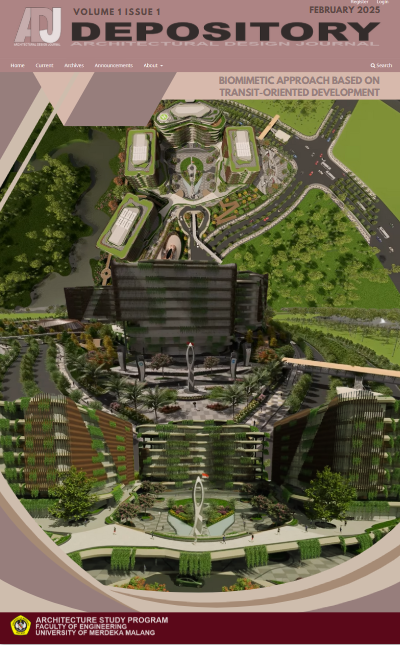MINISTRY OF FINANCE OFFICE COMPLEX IN KIPP-IKN WITH A BIOMIMETIC APPROACH BASED ON TRANSIT-ORIENTED DEVELOPMENT
Keywords:
Bio-mimetic, Finance ministry complex, Transit Oriented DevelopmentAbstract
The Indonesian government is taking significant steps in developing the Nusantara Indonesian Capital (IKN) in Kalimantan, focusing on economic equality and sustainable development. Development of the core government center (KIPP) is a priority, with infrastructure development focused on Phase 1A (2024) and Phase 1 (2025-2029). The Ministry of Finance plays an essential role in this area, with plans to build the Ministry of Finance Office Complex (KPKK) regulated in Presidential Regulation Number 63 of 2022. However, until now, the government has not issued a basic engineering design. Opportunity to propose a Ministry of Finance Office Complex design that supports IKN's vision and mission. The TOD-based Bio-mimetic KPKK design is expected to fulfill the principles of KIPP development. Bio-mimetic, with inspiration from nature and TOD that integrates various modes of transportation and accessibility, provides an innovative approach to design. Implementing these concepts can support IKN as a creative, modern, and sustainable city while ensuring effective regional connectivity.
Downloads
References
Aisyah, S., Aldy, P., Wisata Olahraga Islam Dengan Pendekatan Arsitektur Biomimetik, K., & Hidayat, W. (2020). Kawasan Wisata Olahraga Islam di Pekanbaru Dengan Pendekatan Arsitektur Biomimetik.
Anguluri, R., & Narayanan, P. (2017). Role of green space in urban planning: Outlook towards smart cities. Urban Forestry and Urban Greening, 25. https://doi.org/10.1016/j.ufug.2017.04.007
Arnberger, A., & Eder, R. (2015). Are urban visitors’ general preferences for green spaces similar to those when seeking stress relief? In Urban Forestry and Urban Greening (Vol. 14, Issue 4). https://doi.org/10.1016/j.ufug.2015.07.005
Baharuddin, T., & Kusuma, B. M. A. (2023). Smart City Development in the New Capital City : Indonesian Government Plans. Nal of Contemporary Governance and Public Policy Journal, 4(October), 115–130. https://doi.org/https://doi.org/10.46507/jcgpp.v4i2.141
Brown, R. D., Vanos, J., Kenny, N., & Lenzholzer, S. (2015). Designing urban parks that ameliorate the effects of climate change. Landscape and Urban Planning, 138. https://doi.org/10.1016/j.landurbplan.2015.02.006
De Winne, E. (2006). Towards an integral, accessible public area in the city. The Sustainable City IV: Urban Regeneration and Sustainability, 1, 807–815. https://doi.org/10.2495/SC060771
Hendrix, W. G., Fabos, J. G. Y., & Price, J. E. (1988). An ecological approach to landscape planning using geographic information system technology. Landscape and Urban Planning.
Ibrahim, A. H. H., Baharuddin, T., & Wance, M. (2023). Developing a Forest City in a New Capital City: A Thematic Analysis of the Indonesian Government’s Plans. Jurnal Bina Praja, 15(1), 1–13. https://doi.org/https://doi.org/ 10.21787/jbp.15.2023.1-13
Iojă, I. C., Osaci-Costache, G., Breuste, J., Hossu, C. A., Grădinaru, S. R., Onose, D. A., Nită, M. R., & Skokanová, H. (2018). Integrating urban blue and green areas based on historical evidence. Urban Forestry and Urban Greening, 34. https://doi.org/10.1016/j.ufug.2018.07.001
Krishna, A., Mittal, D., Virupaksha, S. G., Nair, A. R., Narayanan, R., & Thakur, C. S. (2021). Biomimetic FPGA-based spatial navigation model with grid cells and place cells. In Neural Networks (Vol. 139, pp. 45–63). Elsevier BV. https://doi.org/10.1016/j.neunet.2021.01.028
PUPR. (2020). Masterplan IKN.
Zainol, R., Wang, C., Ali, A. S., Ahmad, F., Aripin, A. W. M., & Salleh, H. (2016). Pedestrianization and Walkability in a Fast Developing Unesco World Heritage City. Open House International, 41(1), 112–119. https://doi.org/10.1108/OHI-01-2016-B0016
Sari, I. I. (2019). Bunga Anggrek Hitam Sebagai Ide Penciptaan Karya Batik Pada Kain Tenun Ulap Doyo. In Corak Jurnal Seni Kriya (Vol. 8, Issue 2).
Zachawerus, K W., Rondonuwu, D. M., & Rogi, O. H. A. (2019). “Arsitektur Biomimetik.” Daseng , 8, 923–932.
Zafira, W. S., Puspitasari, A. Y., Rahman, B., Studi, P., Wilayah, P., Kota, D., Semarang, A., & Korespondesi, P. (2022). Penerapan Prinsip Transit-Oriented Development (Tod) Untuk Mewujudkan Transportasi Yang Berkelanjutan Studi Kasus: Kawasan Dukuh Atas Dki Jakarta, Kawasan Plaza Indonesia, Terminal Pal Enam Kota Banjarmasin, Stasiun Lrt Jaticempaka Kota Bekasi. In Jurnal Kajian Ruang (Vol. 2). http://jurnal.unissula.ac.id/index.php/kr
REGULATION:
Presidential Regulation of the Republic of Indonesia Number 63 Of 2022, Concerning Details of the Master Plan for the Nusantara Capital City
Law of The Republic of Indonesia Number 3 of 2022 on National Capital
Law of The Republic of Indonesia Number 21 of 2023 concerning Amendments to Law Number 3 of 2022 concerning the National Capital
Downloads
Published
How to Cite
Issue
Section
License
Copyright (c) 2025 Muhammad Maskur

This work is licensed under a Creative Commons Attribution-ShareAlike 4.0 International License.
Authors who publish in this journal agree to the following terms:
(1) Copyright of the published articles will be transferred to the journal as the publisher of the manuscripts. Therefore, the author confirms that the journal has managed the copyright.
(2) The publisher of DEPOSITORY: Architectural Design Journal is the Architecture Study Program, Faculty of Engineering, the University of Merdeka Malang.
(3) The copyright follows Creative Commons Attribution–ShareAlike License (CC BY SA): This license allows to Share ” copy and redistribute the material in any medium or format, Adapt” remix, transform, and build upon the material, for any purpose, even commercially.






